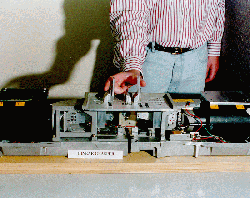  We
have completed a series of psychophysical experiments with the Linear Grasper
designed to characterize human performance in the discrimination of fundamental
mechanical properties of objects. These included several experiments that
measured manual JND (Just Noticeable Difference) in size, force, stiffness,
viscosity, mass, velocity and acceleration (Beauregard, Srinivasan, and
Durlach, 1995). We have also completed an analysis of the subjects' motor
data during the discrimination of viscosity and mass. This analysis revealed
that subjects used statistically the same initial temporal force profiles
when manually discriminating these object properties. Based on this observation,
a mathematical model has been developed to show that this motor performance
gives rise to different spatial variations of force and motion, depending
on the mechanical property of the object being squeezed. From this model,
relationships have been derived that enable predictions for the manual resolution
of object properties to be made solely on the basis of force discrimination.
A comparison of these predicted JND values with the actual JND results has
lead to the postulation of a single sensorimotor strategy capable of explaining
the sensory and motor performance observed in all viscosity and mass experiments.
The "Temporal force control - spatial force discrimination (TFC-SFD) hypothesis"
states that subjects apply a stereotypical force versus time profile (almost
linear ramps) and discriminate on the basis of force versus position profile
(Beuregard and Srinivasan, 1996). This hypothesized strategy has been found
not only to explain the observed motor and sensory data in these discrimination
experiments, but it is also consistent with our previous work on the manual
resolution of mechanical compliance (Tan, Durlach, Beauregard, and Srinivasan,
1995). Implications to the design of virtual environments include specifications
of how accurately the object dynamics need to be simulated and what parameter
values will ensure discriminable objects. We
have completed a series of psychophysical experiments with the Linear Grasper
designed to characterize human performance in the discrimination of fundamental
mechanical properties of objects. These included several experiments that
measured manual JND (Just Noticeable Difference) in size, force, stiffness,
viscosity, mass, velocity and acceleration (Beauregard, Srinivasan, and
Durlach, 1995). We have also completed an analysis of the subjects' motor
data during the discrimination of viscosity and mass. This analysis revealed
that subjects used statistically the same initial temporal force profiles
when manually discriminating these object properties. Based on this observation,
a mathematical model has been developed to show that this motor performance
gives rise to different spatial variations of force and motion, depending
on the mechanical property of the object being squeezed. From this model,
relationships have been derived that enable predictions for the manual resolution
of object properties to be made solely on the basis of force discrimination.
A comparison of these predicted JND values with the actual JND results has
lead to the postulation of a single sensorimotor strategy capable of explaining
the sensory and motor performance observed in all viscosity and mass experiments.
The "Temporal force control - spatial force discrimination (TFC-SFD) hypothesis"
states that subjects apply a stereotypical force versus time profile (almost
linear ramps) and discriminate on the basis of force versus position profile
(Beuregard and Srinivasan, 1996). This hypothesized strategy has been found
not only to explain the observed motor and sensory data in these discrimination
experiments, but it is also consistent with our previous work on the manual
resolution of mechanical compliance (Tan, Durlach, Beauregard, and Srinivasan,
1995). Implications to the design of virtual environments include specifications
of how accurately the object dynamics need to be simulated and what parameter
values will ensure discriminable objects. |


